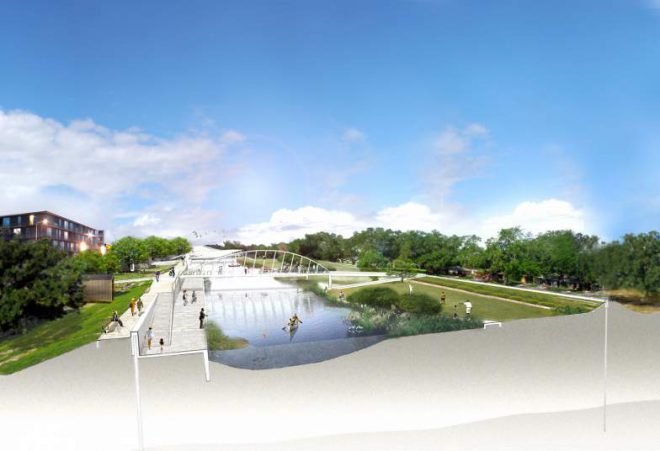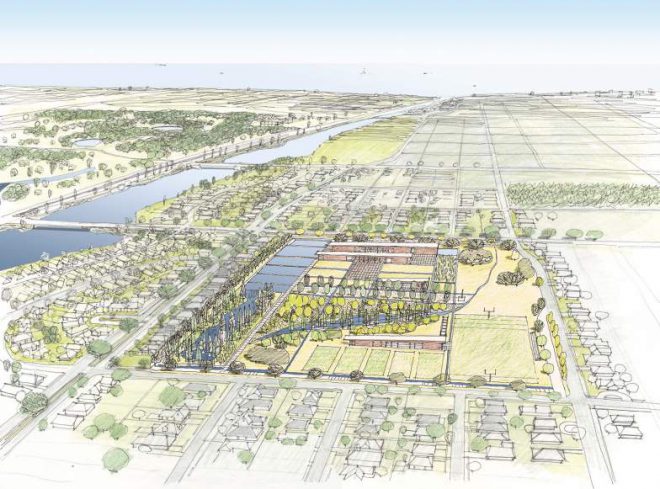A New Vision for Water: Building the Gentilly Resilience District
Benjamin Morris looks at the Gentilly Resilience District, which aims to set a precedent for reducing the impact of rainfall and flooding on New Orleans’ neighborhoods.

A rendering of a proposed project along the London Avenue Canal in Gentilly. Courtesy Waggoner & Ball Architects, New Orleans.
Founded on a river, surrounded on three sides by lakes, and lying a mere stone’s throw from the Gulf of Mexico, New Orleans has always maintained a close relationship to water. Early settlers used its bayous and inlets for trade, subsistence, and passage, and as the city grew, it embraced the peculiarities and demands of its aquatic setting. As a port at the mouth of the Mississippi River, the geographer Peirce Lewis famously called New Orleans “an inevitable city on an impossible site,” highlighting both the need for its existence and the challenges of its terrain.
Water has, without a doubt, played a central role in the story of New Orleans, aiding its growth and offering opportunities for recreation, development, and commerce. Yet for too long, the city’s approach to water has been to keep it firmly at bay: closed off by levees, hidden away with locks and gates, and shunted from one place to the next with maximum speed and volume. Trapped in an unnatural and limiting space, when given the opportunity to find any weak spot or break free of its bounds, water will always take the chance—at times with destructive force, as the events of 2005 so tragically showed.
Following those events, however, a new vision for water in the city’s landscape has emerged. Recognizing that water, conceived as our enemy, will act against us in just that way, a team of architects, urban planners, and engineers have been working since Hurricane Katrina to reshape the city’s relationship to this vital resource. (Efforts were in place before the storm, of course, but took on new significance in its aftermath.) What began in 2006 as a series of engagements with planners in the Netherlands, long famed for their sophisticated integration of water into their country’s urban and rural environments, grew into a series of workshops and publications called the Dutch Dialogues, whereby New Orleans’ public officials and local firm Waggoner & Ball Architects sought to recruit that expertise.
The Dutch Dialogues formally ended in 2011, but those encounters gave rise to a comprehensive vision for the city’s urban layout called the Greater New Orleans Urban Water Plan. This plan, which addresses a wide range of aspects of the physical dimensions of the city—its “streets, neutral grounds, parks, schoolyards, open lots, and houses”—seeks to adopt a more holistic response to water’s presence in this area. Releasing it from such unnatural and dangerous confinement, the city hopes to allow water re-entry into our urban landscape in a way that promotes rehabilitation, acceptance, and integration, reducing the potential impacts of destruction and loss.
For its founders in the Low Countries, this concept has been a safeguard for centuries, but here the idea has only lately gained traction. Leading the charge locally is the new Gentilly Resilience District, a municipal designation that has received a series of federal grants such as the FEMA Hazard Mitigation Grant, a HUD Community Development Block Grant, and, most recently, $141 million from the National Disaster Resilience Competition. Indeed, the Gentilly Resilience District—again, conceived in partnership with Dutch designers—is the first of its kind in New Orleans, and currently serves as the poster child of the city’s overall resilience strategy published in 2015.

A drawing of the Mirabeau Water Garden in Gentilly. Courtesy Waggoner & Ball Architects, New Orleans.
At this point, one may naturally ask: What, apart from its people, makes a district resilient? For urban planners, the answer involves a long list of specific interventions on the street, lot, and house levels that all contribute to a network of benefits that keep water impacts at a minimum and protect from damaging floods. This list includes rain gardens on empty lots, bioswales (a ten-dollar word for ditches) to capture water and prevent its uncontrolled runoff, blueways that mirror greenways as walkable canal areas, green roofs to supply grey water for house plumbing (weatherproofing on a larger scale), and permeable streets and sidewalks that can absorb water rather than leave it to pool as lesser lakes on their surface. All these interventions together can, according to urban planners, reduce the impact of heavy rains and floods by hundreds of thousands of gallons, and prevent needless injury, loss of property, or even death.
Such concerns are felt keenly here in Louisiana, much of which is still recovering from the historic floods this past August, and are felt even more so here in New Orleans, given the memory of its own flood horror. The question is how quickly these benefits will arrive and how soon Gentilly will see these interventions. Certain sites have already been identified—the Mirabeau Water Garden at the site of the former convent of the Sisters of St. Joseph and the Pontilly Neighborhood Stormwater Network, for instance—but progress is uneven. Published timeframes suggest that construction is set to begin anytime now, but with most of the funding still locked up in federal bureaucracy, and recognizing the time required for design reviews and the bidding process, it is unclear how quickly the foot soldiers of sustainability will arrive on the streets.
Other questions linger, too, such as whether a proliferation of empty lots designated as rain gardens will depress a local housing market or whether neighborhood property owners will even consent to such use for their land as opposed to attempting to keep it in commerce. Another question regards the sustainability of this alleged “water economy” itself, and how a sector of design and construction devoted strictly to water management can grow and thrive in the long-term. Designers hope that, if successful, the GRD will serve as a pilot for other neighborhoods not just in the Crescent City but around the region and the country as well. Time will tell, but one thing is clear: Should all these many pieces fall into place, such developments offer a note of hope for a city long weary of its ancient battle with the elements and suggest that after years of needless conflict with one of them, a welcome truce may well be on the horizon.



